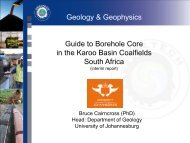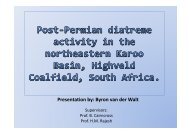coaltech upper olifants river catchment wetland inventory ...
coaltech upper olifants river catchment wetland inventory ...
coaltech upper olifants river catchment wetland inventory ...
You also want an ePaper? Increase the reach of your titles
YUMPU automatically turns print PDFs into web optimized ePapers that Google loves.
3.3 Wetland biodiversity<br />
Wetlands play an important role in the maintenance of biodiversity. Several species from<br />
various taxa are dependant on <strong>wetland</strong>s for breeding and feeding purposes. Although the<br />
species diversity in an individual <strong>wetland</strong> may be low, the overall species diversity in the<br />
<strong>wetland</strong>s of the region may be very high. Several Red Data species occurring within the site<br />
utilise <strong>wetland</strong> habitat, such as the Blue Crane and Nile Crocodile (Kotze et al 2005, Venter<br />
2003).<br />
This section on <strong>wetland</strong> species biodiversity focuses on the plants, invertebrates, fish,<br />
amphibians, reptiles, mammals and bird species that have been recorded in the area.<br />
Various reports contain species lists of the <strong>wetland</strong> species utilising the UORC. The species<br />
lists from the various reports have been entered into one database and are included in<br />
Addendum A to Addendum G.<br />
3.3.1 Species of Concern<br />
The World Conservation Organisation (IUCN) has three threatened categories, namely<br />
Critically Endangered, Endangered and Vulnerable. Species that have been evaluated<br />
according to the IUCN criteria and do not fall into one of the threatened categories can be<br />
classified as Least Concern, Near Threatened or Data Deficient. Species classified as Least<br />
Concern have been evaluated and do not qualify for the Critically Endangered, Endangered,<br />
Vulnerable or Near Threatened categories. Species that are widespread and abundant are<br />
normally included in this category. Species are classified as Near Threatened when they do<br />
not meet the criteria for the threatened categories, but are close to classifying as threatened<br />
or will likely classify as threatened in the near future. A species is classified as a Data<br />
Deficient species when there is a lack of appropriate data on the distribution and/or<br />
population status of the species. The species may be well studied, and the biology known,<br />
but data on the abundance and/or distribution are not available. The category indicates that<br />
more data is needed and that there is a possibility that the species may be classified into one<br />
of the threat categories in the future. Vulnerable species are facing a high risk of extinction in<br />
the wild, Endangered a very high risk and Critically Endangered an extremely high risk<br />
(IUCN 2002).<br />
Wetland Database for UORC - 17 -




